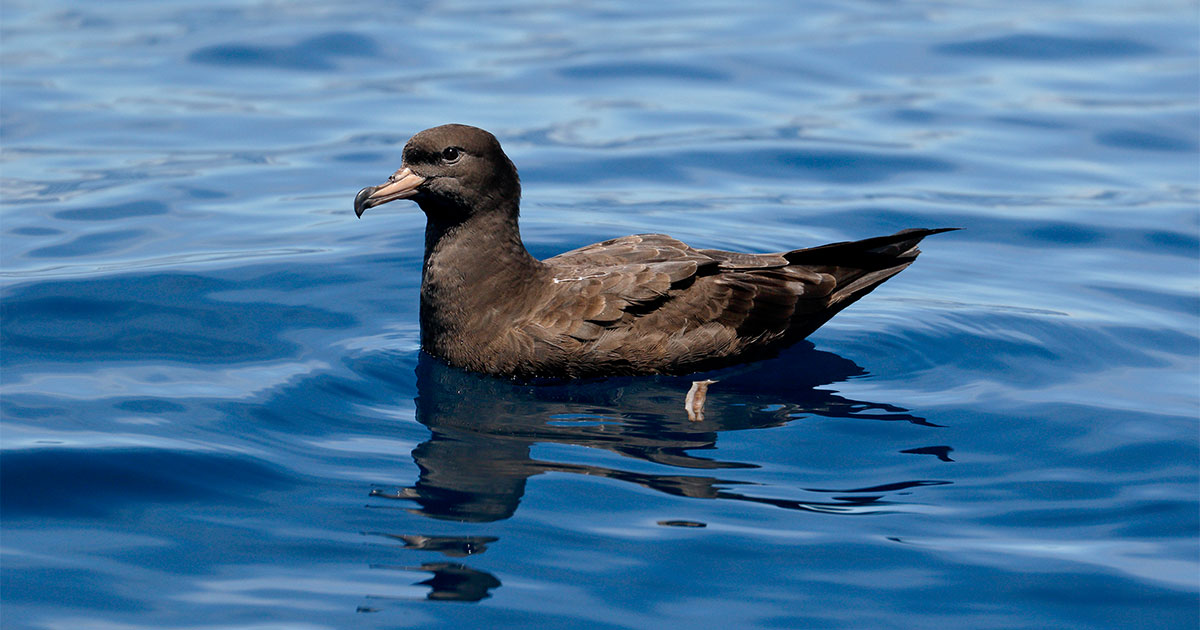Plastic pollution wasn’t discovered floating mid-ocean, far from any shore, until 1971. Today it’s ubiquitous in the lives of seabirds and other marine life. “There isn’t really anywhere left in the ocean that doesn’t have plastic that these birds can find,” says BirdLife International seabird science officer Bethany Clark. According to a 2016 projection, marine plastic could outweigh all the ocean’s fish within decades without action to contain its production and accumulation.
Some seabirds, however, are more harmed by plastic than others. Many species in the petrel and storm-petrel families, for instance, migrate over vast areas of the sea, feeding on the water’s surface where plastic collects. And unlike albatrosses and gulls, these birds don’t easily regurgitate bits and pieces—the indigestible material piles up in their guts instead. What’s more, marine plastic isn’t evenly distributed: Currents and coastlines concentrate the debris in hotspots, so where a species spends most of its time also shapes its exposure.
Only in recent years have location tracking devices become lightweight enough to attach to many petrels, making it possible for the first time to follow these poorly studied birds during their long migrations and nonbreeding months at sea. By analyzing this new wealth of data, scientists hoped to determine which species of petrels are more likely to ingest plastic across their annual life cycle.
In July, researchers at BirdLife and a core team of partner organizations published a study in collaboration with a whopping 200 scientists who offered data from 7,100 tracked seabirds representing 77 petrel species. To calculate a “plastic exposure score” for each species, they first overlaid all the petrel routes with existing data on ocean plastic concentrations. Then they scored each species relative to how much time it spent in high-plastic areas. They also created a map that pinpoints regions that pose the biggest plastic dangers to all 77 species as a whole.
The results raised several red flags. Six of the 10 species with the highest plastic exposure scores are already classified as vulnerable, threatened, or endangered—mostly due to ongoing threats such as invasive mammals on their breeding islands and entanglement in fishing nets. Those include Balearic and Yelkouan Shearwaters in the Mediterranean Sea and Hawaiian Petrels in the Pacific Ocean. Plastic ingestion only compounds their problems, says Maria Dias, an ecologist at the University of Lisbon and one of the study’s coauthors. And while the most severe plastic exposure was found in the Mediterranean and Black Seas, risk was distributed around the globe—often on the high seas located beyond the exclusive economic zones of individual coastal nations.
Richard Phillips, a seabird ecologist with the British Antarctic Survey and study coauthor, hopes that the study’s results provide even more impetus for international cooperation on the issue—especially as nations meet in November to negotiate a global treaty to curb ocean plastic pollution. “Action by just a few nations wouldn’t make that much of a difference, and I think that’s where our study comes in,” he says.
With vast spans of sea far from view, people have long considered birds to be sentinels for healthy ocean ecosystems, says Adrift Labs marine biologist and study coauthor Jennifer Lavers. Her long-running research on Australia’s Lord Howe Island has shown that plastic causes dangerous stomach scarring and alters blood chemistry in Flesh-footed Shearwaters. When seabirds suffer from plastic, Lavers says, so do we all.
Who Goes Where
The study analyzed the plastic exposure of 77 species tracked along their migration from a variety of breeding colonies. Below are a few species of interest.

Northern Fulmar: An international body that regulates the northeast Atlantic Ocean analyzes beached fulmars to gauge overall levels of floating marine debris. In 2022, 51 percent of birds analyzed had concerning levels of plastic in their stomachs.
Yelkouan Shearwater: By breeding and migrating within the largely enclosed Mediterranean and Black Seas, where plastic accumulates, this bird—already considered vulnerable—was ranked the most exposed to plastic.

Spectacled Petrel: Ranked among the 10 birds in the study most exposed to plastic, this petrel is especially vulnerable: It breeds in only a single location, called Inaccessible Island, within a plastic exposure hotspot in the south Atlantic Ocean.
Barau’s Petrel: A 2019 study of nine species that breed on Reunion Island in the Indian Ocean found that the endangered Barau’s was among the most affected by plastic; the pollutant was found in 60 percent of individuals sampled.

Flesh-footed Shearwater: On Australia’s Lord Howe Island, scientists have found fledglings with severe stomach scarring from being fed plastic by their ocean-foraging parents, as opposed to healthy tissue. The species also encounters plastic during migration.
Cook’s Petrel: Migration routes matter: Two nearby breeding populations of this species spend the nonbreeding season in different ocean regions. One is highly exposed to plastic during those months; the other, hardly at all.
Snow Petrel: This bird, which ranges within the Southern, or Antarctic, Ocean had the lowest plastic exposure of all 77 species. Nonetheless, it, too, has been found to eat plastic, indicating no bird can completely escape contamination.
This story originally ran in the Fall 2023 issue as “Hotspots.” To receive our print magazine, become a member by making a donation today.
Graphics: Julie Rossman. Data: Clark B.L. et a. Nature Communications (2023), DOI: 10.1038/S41467-023-38900-Z, and Bethany Clark/Birdlife International

